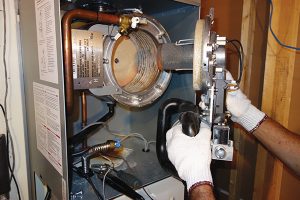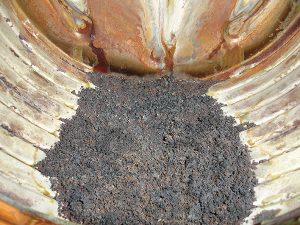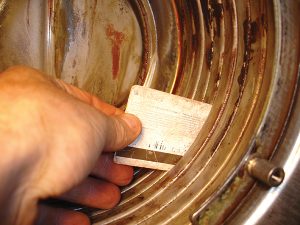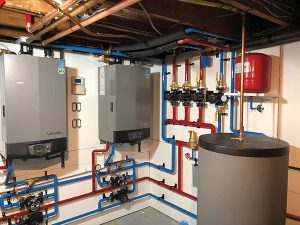
Step-by-step prep: Preparing condensing boilers for winter
December 12, 2018 | By Rob Waters
Every year the impending winter season prompts Canadians to prepare for winter. Safely storing summer gear, closing the pool or cottage, putting snow tires on our vehicles are things we know we have do before old man winter arrives with a vengeance. But are your customers’ condensing boilers ready for the rigours of the upcoming season?
Heating systems in Canada work very hard combating long winters, and a condensing boiler with a modulating burner will rack up lots of run hours. Ideally they should all have an annual service check up to ensure that everything is in peak operating condition. Like many pieces of mechanical equipment however, preventive maintenance for boilers is not always preformed like it should be.
Doing a few simple tasks will ensure that a condensing boiler is prepared for winter, as well as ensuring that it performs efficiently and reliably for many years to come.
Condensing boilers are usually constructed with stainless steel heat exchangers, full modulation burners, and high-tech control systems. Due to their construction and components these boilers have a higher cost investment than traditional non-condensing boilers. It makes sense to take care of this investment to ensure a long and reliable service life.
It is interesting to compare servicing requirements for an automobile with a condensing boiler. When someone buys an expensive automobile they usually pay close attention to the manufacturer’s service requirements, and take the vehicle in for regular service and maintenance.
Why is it not the same for heating boilers? Just like an automobile it is an expensive investment and it also needs to be serviced to keep it in optimum operating condition.
Any thorough pre-winter service call should start with a general overview of the boiler installation and the mechanical room.
Darryl Singleton, vice president of Aqua-Tech Sales and Marketing Inc. in Burlington, ON, says “We always stress to our service technicians and contractors to check the environment first and think about everything that goes into the box before you start taking anything apart. By looking for clues upfront, you can often anticipate problems that you will see in the boiler.”
A general inspection should include looking closely at the venting system inside and outside to see if it is compromised in any way. With sealed combustion units, both the exhaust pipe and the intake pipe should be inspected for signs of debris build-up or small animal intrusions. Clean out any debris and repair any joints that show any signs of leakage before you start working on the boiler.
Inside the mechanical room inspect all of the hydronic piping and components carefully for any signs of water leakage. Look around the boiler area to see if any chemicals/liquids are being stored close by, and remove if necessary.
A quick check of the delta-T on the heating circuit can indicate possible problems with the circulating pumps. All of these quick initial checks will now set the stage for the main part of the boiler specific servicing to be performed.
The two primary areas that must be addressed when servicing a condensing boiler are the heat exchanger and the modulating burner assembly. Condensing boilers sold in Canada are available from a large number of manufacturers, however the heat exchangers are generally one of two types: stainless steel water tube (usually a coil design) and stainless steel fire tube design. There are other design types, as well as aluminum heat exchangers, but this article will focus on these first two primary design types.
The fireside surfaces of the stainless steel heat exchanger (HX) should be inspected and cleaned annually. This requires that the gas connection be shut off, and the burner be removed. Depending on the model of boiler you are working on this can be relatively simple process, or may require some considerable disassembly of components. How much cleaning of the burner and the heat exchanger is required depends a lot on the environment the boiler lives in. Whatever gets drawn into the combustion air intake, such as dust, pollen and bugs, will tend to accumulate inside the boiler.
In general if the environment is clean then the burner/HX will tend to be fairly clean. This is not always the case however, and there are many examples of dirty environments which can cause significant burner/HX fouling issues. These include rural and agricultural areas, and areas with construction in the neighbourhood.
Even in clean environments, there are still organic compounds in the gaseous fuel that can cause deposits to form in the burner/HX. Build-up tends to be worse with propane gas so pay special attention to boilers burning this fuel.
Another thing to consider is that modern condensing boilers have much smaller flue gas passageways than old style cast iron and fin tube boilers making them more susceptible to fouling.
Once the fireside surface of the HX is exposed it must be cleaned. The cleaning should start with a vacuum cleaner to remove any larger particles that have accumulated in the combustion chamber. It is not advisable to use compressed air to blow anything out, as this can force particles farther into the flue gas passageways where they can become trapped. After vacuuming out all the larger particles, a nylon or plastic brush can be used to further clean the surfaces.
Metal brushes should never be used on stainless steel as they can damage the surface and shorten the material lifespan. Water can be sprayed into the heat exchanger to help cleaning, as it will drain out through the condensate p-trap.
With water tube coil HX designs the gaps between the coils often needs to be cleaned. Something that works very well for this is an old plastic gift or credit card. Just make sure you do not get it jammed in too tight.
Mark Norris is the Viessmann Academy instructor at Viessmann Manufacturing in Waterloo, ON, and he explains that Viessmann sells a special metal gap cleaning tool for their boilers. According to Norris however, “This is the tool of last resort. It should only be required for boilers that have been severely fouled due to neglect. If the heat exchanger is cleaned annually with a nylon brush this tool should not be required.”
Condensing boilers with fire tube HX designs typically have the fire tubes that are oriented vertically. This helps provide them with a certain amount of self-cleaning effect. Vertical designs however are sometimes harder to inspect and get access to when they do need cleaning. Surfaces should be cleaned by vacuuming, wiping with a cloth or nylon brush, and rinsing with water.
In some cases the HX may need further cleaning and it is possible to use solvent-free cleaning solutions to remove surface coatings and discolouration. Cleaners used would typically be phosphoric or citric acid-based. If chemical cleaners are used it is very important to carefully follow boiler manufacturer’s instructions and the Material Safety Data Sheet (MSDS) of the cleaning agent manufacturer. All surfaces must be thoroughly flushed with water after cleaning.
The modulating burner assembly is next on the cleaning agenda as it must also be inspected and cleaned to keep it operating efficiently. In general pre-mix burners are not easily fouled, but they are at the mercy of their environment and whatever ends up coming in the air intake.
According to Singleton, “Things can live in a pre-mix burner, especially organic material such as bugs, pollen and dust.” Singleton also mentions that fouling problems are not always evident. “The self-adjusting nature of a modern power burner can keep the burner operating with no lock-outs. The burner and HX could still be very fouled however.”
Burners will have either mesh screens or very small holes which must be kept clean. Dirty areas on a burner can lead to hot spots which leads to material stress and poor combustion. Surfaces must be carefully vacuumed and brushed to remove debris. In cases of severe fouling the burner should be completely disassembled to clean all of the internal surfaces. With the burner out, check the condition of any refractory material and gaskets, and replace if they show any sign of wear.
Before reassembling the burner, the ignition and flame sensing electrodes must be inspected. The electrodes should be visually inspected for signs of fouling, change in shape, or damage to the porcelain components. Electrodes can be cleaned with a plastic brush or fine grit sandpaper. If the electrodes cannot be cleaned satisfactorily, are warped, or are just getting old, it is recommended that you replace them.
Norris says “Electrodes are consumables, and should be replaced regularly. Electrodes are exposed to extremely high heat, and the stress on the metal tends to kill them over time. They are relatively inexpensive compared to the cost of a job site visit for a burner lock-out. You could spend time cleaning and re-installing the old ones, and still be back to the job a month later when they finally fail.”
A final thing to look at on the burner is the ground wiring. A good ground path is essential for flame sensing, but it is often overlooked. Carefully check that all wiring is in good condition and is securely attached. Check the ground continuity using a continuity meter, and replace any ground wires or terminals if necessary.
After cleaning the boiler’s heat exchanger the condensate disposal system must be inspected and cleaned. Condensate that is created in the combustion chamber must always have a free path to flow away. If it plugs up with debris, then the condensate will back up into the appliance and eventually result in a burner lock-out. The main components of the condensate system are the p-trap, the piping to the drain, and optionally a condensate pump and a condensate neutralization system.
All of these components should be regularly cleaned and flushed. Most boilers have integrated p-traps that can be easily removed, disassembled and flushed out. Remember to fill the p-trap with some fresh water prior to starting up the boiler.
Now that heat exchanger, burner and condensate system have all been cleaned and reassembled, it is important to verify that you have good combustion. Modern condensing boilers are designed with a very fine tuned combustion process to maximize efficiency. They are not as forgiving as an atmospheric burner, so the combustion process must be verified and set up properly at commissioning and when serviced. It is not possible on most condensing boilers to actually see the flame in the combustion chamber. The only way to tell if the burner is running cleanly and efficiently is to use a combustion analyser to measure the flue gases. Verify that the CO2 levels are as per the boiler manufacturers recommended ranges. If required follow the manufacturer’s instructions to adjust the gas and air ratios to achieve good combustion.
Other components of the hydronic system must also be inspected and periodically serviced. These include, but are not limited to, the pumps and zone valves, expansion tank, relief valves, air vents and low water cut-offs. All of these components have specific servicing requirements, but unfortunately there is not enough space in this article to address them all in detail. A good topic for another time.
Condensing boilers when installed and serviced properly should give years of trouble free service. Maintenance however cannot be ignored. With their precision burner setups and their small flue gas and water passageways, serious issues can arise when they are neglected.
Singleton stresses that, “if you treat the investment with respect, it will serve you for many years.”
This is good advice to follow for all mechanical systems, but especially for condensing boilers. Now that the boiler is serviced you are ready to get the skis, skates and sleds out for some winter fun! <>
Robert Waters is president of Solar Water Services Inc., which provides training, education and support services to the hydronic industry. He has over 30 years experience in hydronic and solar water heating. He can be reached at solwatservices@gmail.com.








